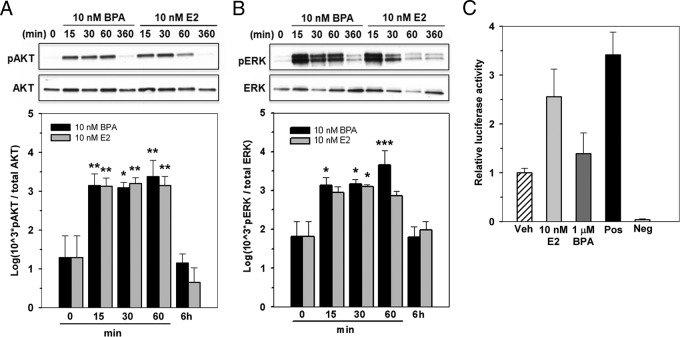Figure 3.
Estradiol and BPA have equimolar activational capacities for ER rapid signaling pathways but differential genomic ERE capacity in human prostaspheres. A and B, Day 7 prostaspheres grown in the absence or presence of 10 nM BPA or E2 (n = 4) for 15, 30, or 60 minutes or 6 hours were assessed for p-Akt/total Akt (A) and p-Erk/total Erk (B) by Western blot assay. Representative blots (top) and graphic representations of densitometry analysis from 4 separate cultures (bottom) are shown. Both 10 nM E2 and 10 nM BPA markedly increased Akt phosphorylation at 15, 30, and 60 minutes with a return to baseline activity by 6 hours (A). *, P < .05; **, P < .01 vs vehicle. A similar temporal profile was observed for ERK phosphorylation (B). *, P < .05; ***, P < .001 vs vehicle. C, Genomic ERE signaling activity in day 7 prostaspheres was evaluated using an ERE-tk-Luc reporter assay (see Materials and Methods). Day 6 prostaspheres pretransfected with the luciferase ERE-tk reporter and a Renilla-luciferase control construct were treated with 10 nM E2 or 1 μM BPA for 16 hours, and ERE reporter activity was measured by a Dual-Luciferase Reporter Assay System. E2 at 10 nM increased tk-luciferase activity ∼2.5-fold compared with the vehicle (Veh)–treated cells (n = 3), similar to activity seen in the positive control vector. Treatment with 1 μM BPA did not increase luciferase activity above that for vehicle treatment.

